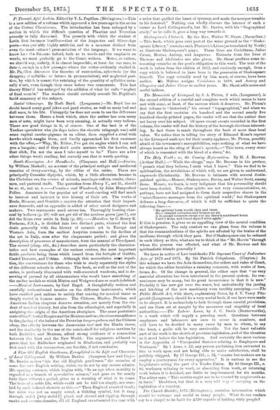South-Kensington Art Handbooks. (Chapman and. Hall.)—Ivories, by William Haskell; an
account of the principal antique and medians' remains of ivory-carving, by the editor of the series. These are principally Consular diptyche, whioh, by a little alteration, became in the Christian era the covers of missals, marriage-coffers, combs, chess- men, and pastoral staffs. The quotation from• Henry V., act iii., should be Sc. vi., not se. e and Woodwork, by John Hungorford Pollen. Amateurs in the popular art of wood-carving will find much to interest and instruct iu this history of their• art. The works of Bonle, Rieseur, and Gonthiel e receive the attention that their import- ance demands, and an appendix is added of other noted designers and makers. Two statements need correci ion. Thoroughly heating char- coal by bellows (p. 29) will not get rid of the noxious gases (gas ?), nor did the Huns ever settle in Italy (p. 39).—Maiolica, by C. Drury E. Fortnum, F.S.A., is divided into two distinct parts, whereof the first deals generally with the history of ceramic art in Europe and Western Asia, from the earliest Assyrian remains to the decline of the art in Italy, soon after the cinquecento period ; and gives the description of processes of manufacture, from the manual of Piccolpassi. The second (chap. viii., &c.) describes more particularly the character- istics and best examples of the various centres, the most important fictilo products being those which issued from the botteghe of Gubbio, -Castel Durante, and Urbino. Although this necessitates some repeti- tion, the convenience for those who wish to study separately the styles of the different schools is obvious. The book, as well as the rest of the series, is profusely illustrated with well-executed woodcuts, and is de- serving of perusal by all cbinomaniaos who would know something of the earlier models to which Minton and Wedgwood are so much indebted. —Musical Instruments, by Carl Engel. A thoughtfully written and carefully authenticated treatise on the different instruments, which have enabled past nations to satisfy that craving for musical tones so deeply seated in human nature. The Chinese, Hindoo, Persian, and American. Indian chapters deserve attention, not merely from the stu- dent of musical history. but also from the ethnologist, and especially in assigning the origin of the American aborigines. The same pentatonic scale of the Celestial Empire and the Mexican nations, the close resemblance in the placing of the holes of the Peruvian huayra-puhura and the Chinese -cheng, tho affinity between the Amazonian turd and the Hindu tooree, and the similarity in the use of the conch-shell for religious services by both Buddhist. and Mexican, afford strong evidence of a connection between the East and the New World.- The arguments adduced to prove that the fiddle-bow originated in Hindustan, and probably was first used with the raeanastron, are forcible, if not conclusive.


































 Previous page
Previous page